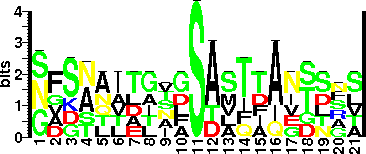
| Technique(s) used for Glycosylation Detection | Rapid migration on SDS-PAGE after chemical deglycosylation with TFMS, glycoprotein staining using GelCode-glycoprotein staining kit. |
| Technique(s) used for Glycosylated Residue(s) Detection | Site-directed mutagenesis and MALDI-TOF MS (matrix assisted laser desorption/ionization time of flight mass spectrometry) analysis |
| Protein Glycosylation- Implication | Glycosylation, especially at positions S176 and S183, is required for smooth motility and bacterial virulence. Glycosylation is one of the important process in bacterial HR-inducing (hypersensitive reaction, a rapid and strong plant defence response) activity. Glycosylation may also serve to mask elicitor function of flagellin molecule in order to avoid plant recognition. Glycosylation of sites that are most surface-exposed plays a role in the swarming motility of the P. syringae pv. tabaci 6605. |
| Glycan Information |
| Glycan Annotation | Linkage: α-L-Rha-Ser.
Tetrasaccharide, 4,6-dideoxy-4-(3-hydroxybutanamido)-2-O-methyl-Glcp-(1→3)-α-L-Rhap-(1→2)-α-L-Rhap-(1→2)-α-L-Rha-(1→, as well as a trisaccharide, 4,6-dideoxy-4-(3-hydroxybutanamido)-2-O-methyl-Glcp-(1→3)-α-L-Rhap-(1→2)-α-L-Rha-(1→. Rhamnose (Rha) is exclusively of the L form. 4,6-dideoxy-4-(3-hydroxy-3-methylbutanamido)-2-O-methylglucopyranose is named as viosamine. Therefore, in the glycans, modified viosamine is present.
The ratios of a trisaccharide and a Tetrasaccharide on LC by fluorescence detection were about 5:1, indicating that about five serine residues (including S201) were glycosylated with a trisaccharide. The major component of each glycan is similar to that at S201.
Microheterogeneity in glycosylation is observed. |
| BCSDB ID | 24060 |
| GlyTouCan | G86886TI |
| Technique(s) used for Glycan Identification | Sugar composition analysis using an ABEE (p-aminobenzoic acid ethyl ester) labeling kit, MALDI-TOF MS (matrix-assisted laser desorption ionization?time-of-flight mass spectrometry), determination of D-Rha/L-Rha ratios using gas chromatography (GC), and 1H-NMR analyses including 1H-1H correlation spectra [DQF-COSY (double quantum filtered correlation spectroscopy), TOCSY (total correlation spectroscopy), and NOESY (nuclear Overhauser and exchange spectroscopy)] and 1H-13C correlation spectra [HSQC (heteronuclear single-quantum coherence) and HMBC (heteronuclear multiple bond connectivity)]. |
| Protein Glycosylation linked (PGL) gene(s) |
| Characterized Accessory Gene(s) | FGT1 and FGT2 are two glycosyltransferases which are encoded in the flagellin glycosylation island. Non-glycosylated and partially glycosylated flagellins were respectively produced by fgt1 and fgt2 mutants. |
| Literature |
| Year of Identification | 2003 |
| Year of Identification Month Wise | 2003.3.1 |
| Year of Validation | 2006 |
| Reference | Taguchi, F., Yamamoto, M., Ohnishi-Kameyama, M., Iwaki, M., Yoshida, M., Ishii, T., Konishi, T. and Ichinose, Y., 2010. Defects in flagellin glycosylation affect the virulence of Pseudomonas syringae pv. tabaci 6605. Microbiology, 156(1), pp.72-80. |
| Corresponding Author | Yuki Ichinose |
| Contact | Laboratory of Plant Pathology & Genetic Engineering, Faculty of Agriculture, Okayama University, Tsushima-naka 1-1-1, Okayama, 700-8530 Japan. |
| Reference | Konishi, T., Taguchi, F., Iwaki, M., Ohnishi-Kameyama, M., Yamamoto, M., Maeda, I., Nishida, Y., Ichinose, Y., Yoshida, M. and Ishii, T., 2009. Structural characterization of an O-linked tetrasaccharide from Pseudomonas syringae pv. tabaci flagellin. Carbohydrate research, 344(16), pp.2250-2254. |
| Corresponding Author | Tadashi Ishii |
| Contact | Forestry and Forest Products Research Institute, 1, Matsunosato, Tsukuba, Ibaraki 305-8687, Japan. |
| Reference | Takeuchi, K., Ono, H., Yoshida, M., Ishii, T., Katoh, E., Taguchi, F., Miki, R., Murata, K., Kaku, H. and Ichinose, Y., 2007. Flagellin glycans from two pathovars of Pseudomonas syringae contain rhamnose in D and L configurations in different ratios and modified 4-amino-4, 6-dideoxyglucose. Journal of bacteriology, 189(19), pp.6945-6956. |
| Corresponding Author | Kasumi Takeuchi |
| Contact | National Institute of Agrobiological Sciences, Kannondai 2-1-2, Tsukuba, Ibaraki 305-8602, Japan. |
| Reference | Taguchi, F., Takeuchi, K., Katoh, E., Murata, K., Suzuki, T., Marutani, M., Kawasaki, T., Eguchi, M., Katoh, S., Kaku, H. and Yasuda, C., 2006. Identification of glycosylation genes and glycosylated amino acids of flagellin in Pseudomonas syringae pv. tabaci. Cellular microbiology, 8(6), pp.923-938. |
| Corresponding Author | Yuki Ichinose |
| Contact | Laboratory of Plant Pathology & Genetic Engineering, Faculty of Agriculture, Okayama University, Tsushima-naka 1-1-1, Okayama, 700-8530 Japan. |
| Reference | Taguchi, F., Shimizu, R., Inagaki, Y., Toyoda, K., Shiraishi, T. and Ichinose, Y., 2003. Post-translational modification of flagellin determines the specificity of HR induction. Plant and cell physiology, 44(3), pp.342-349. |
| Corresponding Author | Yuki Ichinose |
| Contact | Laboratory of Plant Pathology & Genetic Engineering, Faculty of Agriculture, Okayama University, Tsushima-naka 1-1-1, Okayama, 700-8530 Japan. |